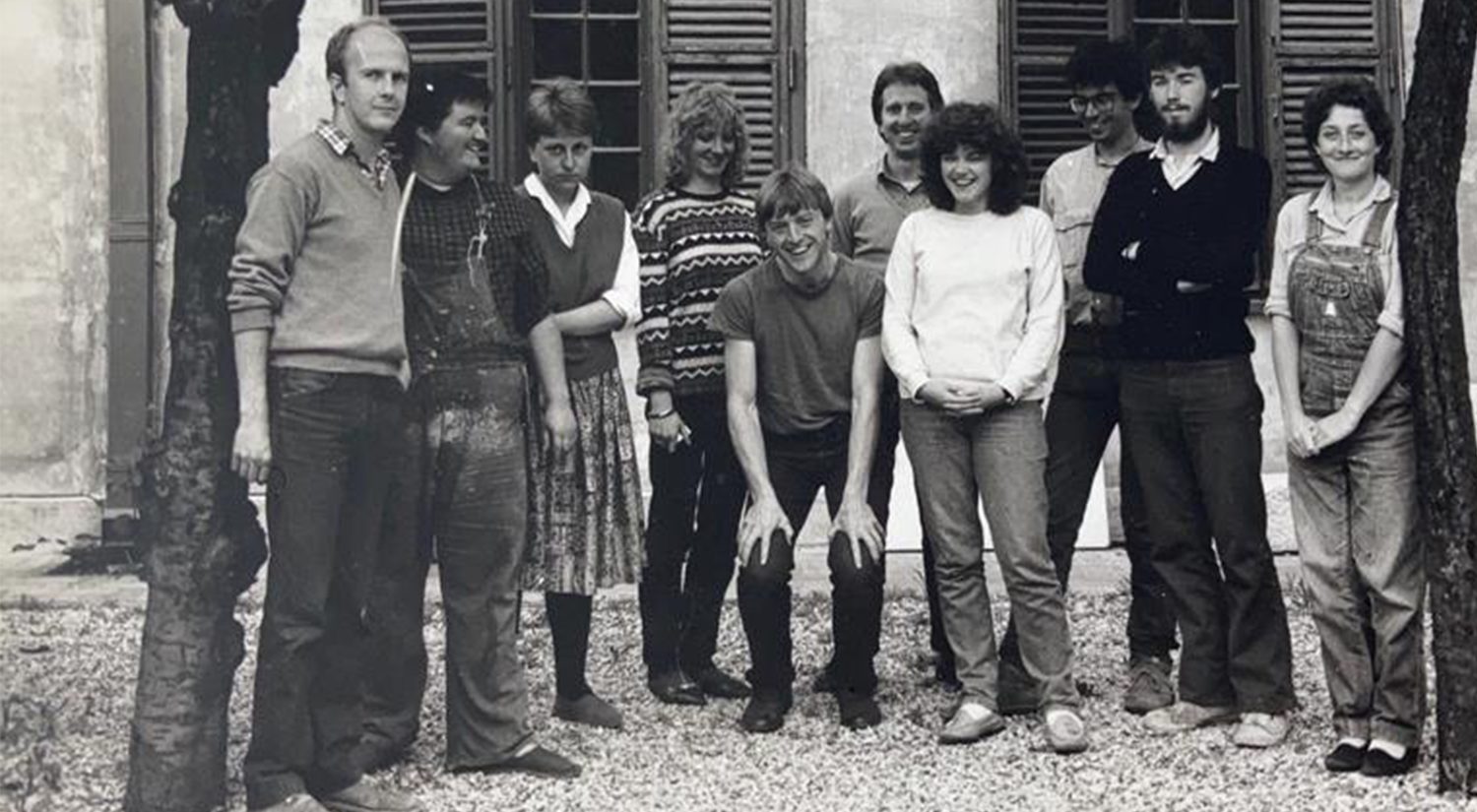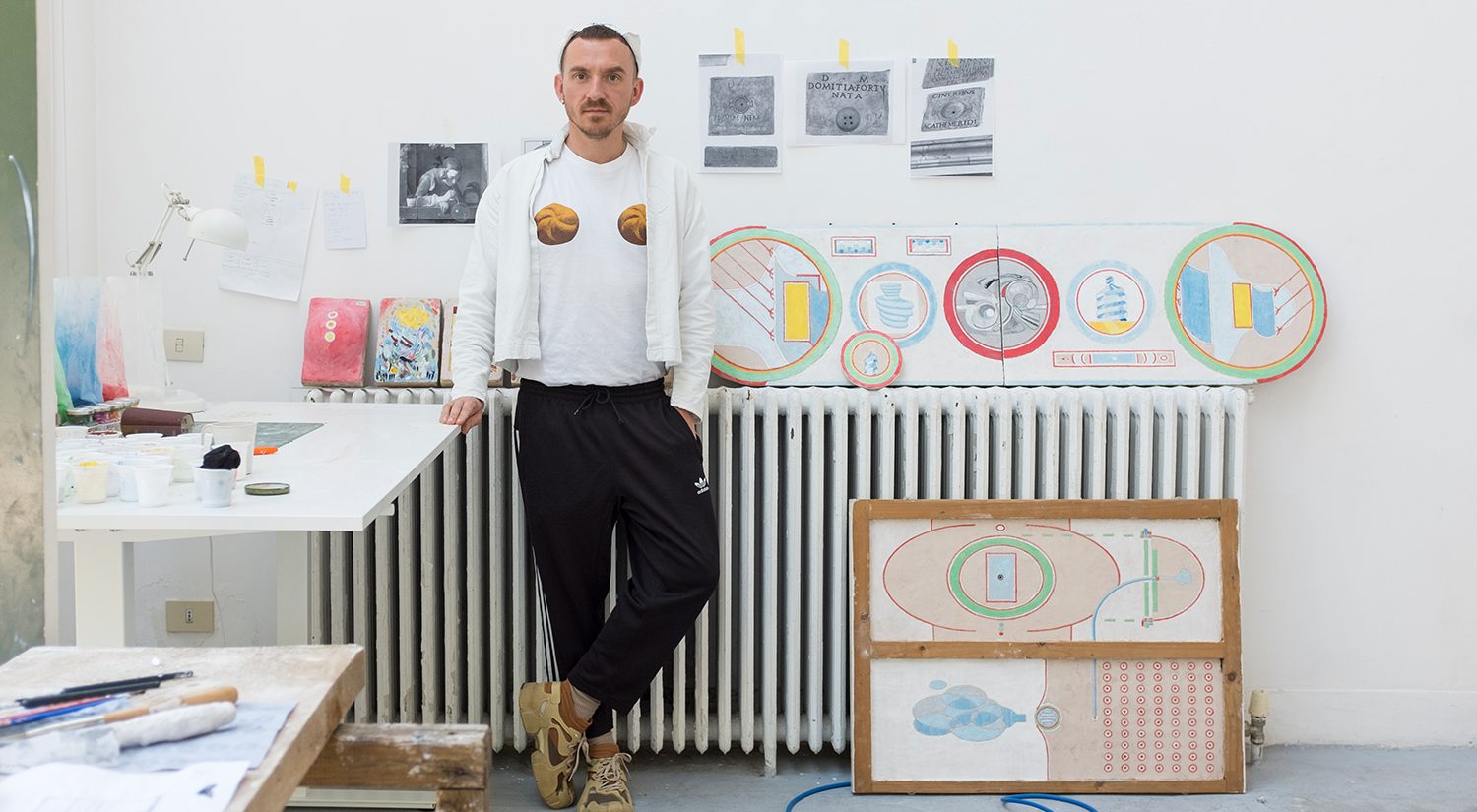Marta Pellerini (Visual Art Residency and Programme Curator), Max Fletcher (Sainsbury Scholar in Painting and Sculpture 2019–2020) and Mick Finch (Professor of Visual Art Practice, Central Saint Martins) reflect on the March Mostra 2021. The text takes the form of an imagined conversation in the absence of a physical audience due to Covid-19 restrictions.
M. PELLERINI: On March 12, the March Mostra 2021 at the British School at Rome opened, with works by Charlie Fegan and Max Fletcher. Just that morning I had read the news that our region would become a red zone and go into lockdown from Monday 15 March for a minimum of two weeks. And so it was. The exhibition opened to the public for three hours. With almost 27,000 Covid-19 cases and 380 deaths (data as of March 12) the announcement was no surprise.
Charlie Fegan and Max Fletcher, both Sainsbury Award holders, had been the only artists-in-residence at the BSR for three months. Max Fletcher returned to the BSR in September 2020 to complete the remaining six months of his residency which had been cut short by the onset of Covid-19, just as Charlie began his. For the first time ever, the March Mostra took the form of two solo shows / a duo show / a duet. Although distinct, both artists have, in their own way, dealt with what they describe as ‘uncoordinated temporality’ and ‘historical summonings’.
In his project for the March Mostra, Charlie Fegan designs a future memorial that takes the war memorials of architect Edwin Lutyens as a starting point, developing a structure that recalls the linearity of Carlo Scarpa’s architecture and the transparency of Lauretta Vinciarelli’s architectural drawings. The artist’s gaze shifts from the past to the present by emphasizing the relationship between death and ecology.
One of the most debated topics of the last year has been the link between the pandemic and our planet’s health. What we are facing is a consequence of the Anthropocene and a warning to human beings who consider nature to be a nurturing mother that can be endlessly exploited. This patriarchal model is old and in crisis. Ecologists and ecofeminists are fighting it for the survival of the planet.
Activating a gaze towards the future involves looking critically at the past to negotiate the present.
Equally, Max Fletcher’s works for the March Mostra evoke a temporal path that begins with Antonio Gramsci’s journey to Turi prison in 1926 and ends with a painting of Matteo Salvini eating a hamburger. A canvas which represents the avidity of the political class. Next to it, hangs a triptych inspired by William Morris’s utopian novel News from Nowhere in which the narrator, a late 19th-century man and clearly the author’s alter-ego, is magically transported into a distant future (1952). England is free from capital, Trafalgar Square is no longer chaotic, but a peaceful area of London, with elegant houses, overflowing gardens and audible bird song. Morris’ themes still resonate in 2021; the desire to create a world where work is creative and joyful, necessary criticism of the excessive power of science and technology, realisation of the importance of the natural environment, the victim, together with human beings, of environmental degradation and capitalist exploitation. One of Morris’s great admirers, Oscar Wilde, recalled a comment made by Morris: “I tried to make every worker an artist, and when I say an artist, I mean a man”

M. FLETCHER: A popular far right politician is spotted in a chain restaurant eating a hamburger. While such an event is in no way remarkable, or even really of note, it is a good opportunity for the press photographers. After all, the best photographs are often of commonplace occurrences. A politician scoffing a patty of processed meat serves as a metaphor for greed. A newspaper clipping of the published image, tacked to a public notice board, has been given a caption. Prima Io, Dopo Voi, Forse. First Me, Then You, Maybe. A painting of this text/image combination was shown on the far wall of the gallery, immediately visible to the viewer upon entering the space.
The politician eating the hamburger is Matteo Salvini. As an image it is a simple one and is rooted very much in the present day. This being so, it provides a counterpoint to the other work that I showed in the mostra, which was based on Antonio Gramsci’s time imprisoned in Turi and William Morris’ novel News From Nowhere, drawing lines between history and the present. The subject of the painting both is and is not Salvini. On one hand it is unmistakably the current leader of Lega Nord, yet the figure eating the hamburger could be any number of far right populist political figures currently enjoying a resurgence. The mostra came a year on from Italy’s first lockdown, and only this week, Boris Johnson declared to backbench conservative MPs that the UK’s relative vaccine success is down due to “greed” and “capitalism”. Prima Io, Dopo Voi, Forse.
M. FINCH: I met remotely with Charlie and Max during the latter part of their tenure at the British School at Rome. I had chaired the committee of the Sainsbury/Lindbury Trust panel that had selected them for the residency and, as the effect of the pandemic dug deeper, support seemed appropriate. They coped well with the extraordinary conditions of being at the British School and in Rome at this time. This was not the usual experience of an award holder. Access to the cultural resources of the city and to the normally thriving community of the School was limited. The centre of Rome was emptied of its usual traffic of tourists, a strange pause in Rome’s burden of its geological time spans, manifest as endless seams of cultural artefacts.
They strangely shared much in this time. They both work into a past whose where and when is at first unclear. This displacement works as temporal mechanisms, possibly to engage an intangible present and an even more slippery future. The references, the working processes and the exhibition dispositifs they both employ are intriguing and complimentary.
Max Fletcher’s references, so well described by himself, are brought to together both in the processes by which his work is made and through their juxtaposition in the gallery, as constellations and collisions, precipitating an opening onto a present. Gramsci’s incarceration in Turi, the ceramic cattle trucks scattered around the gallery, edge the viewer toward associations with the railway cattle wagons of fascist entangled histories. A similar wagon is represented in a painting bearing the letters LNER, London North Eastern Railway and ‘First Me, Then You, Maybe’ finds a chilling place in the present unfolding before us, here and now. His reference to William Morris compounds his working process. Reaching back into historical aporia from which he pulls far flung coordinates that assemble around a vanishing point within the present.
Charlie Fegan’s work is a proposition for a memorial. It unfolds into a perpetual moment rather than that of an historic event. He does this through a series of works on paper. The source of the thinking of the structure[HO6] goes back to a Lutyens’ Thiepval Memorial to those lost in the Somme with no grave, that in itself is an extraordinary sculptural form. Charlie situates his memorial upon a sea within an eternal sunset. He counterposes these totalised, object-based views with those from within the memorial, the mortal and the eternal in a mode of point and measure. The works on paper are finally pinned onto massive black boards, gathering them synoptically together within a space that all but engulfs them.












